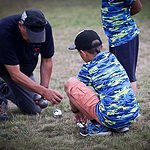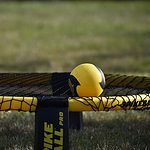When serving a pickleball, have you ever wondered about the subtle yet essential details that can elevate your game? Understanding the mechanics behind a successful serve sets the tone for your performance on the court.
It's not just about hitting the ball over the net; there's a finesse to it that can make all the difference in your gameplay. Let's explore the nuances of pickleball serving techniques and strategies that can give you the edge during matches.
Key Takeaways
- Use proper technique: underhand motion, diagonal serve, follow through for control.
- Add spin for variety: topspin, backspin, side spin for unpredictability.
- Generate power: utilize legs, increase paddle speed, consistent technique for reliability.
- Master placement: serve deep, center, follow through accurately, dictate pace strategically.
Pickleball Serving Fundamentals
To serve effectively in pickleball, master the essential techniques outlined in the following section on Pickleball Serving Fundamentals. When serving, remember to use an underhand motion with an upward arc to ensure the ball clears the net. Position the highest point of your paddle head below your wrist to make a clean contact with the ball. Aim your serve diagonally opposite to the receiver's service court for strategic placement. After hitting the serve, follow through towards your target to maintain control and return to the ready position promptly.
Serving deep and to the center of the court can pressure the receiver, forcing them to move back and giving your team an advantage in the point. By placing your serves effectively, you can set up your team for success in the rally. Remember to stay focused, keep your body in the ready position, and anticipate your opponent's next move after the serve. Mastering these fundamental serving techniques will enhance your pickleball game and give you an edge on the court.
Proper Pickleball Serve Technique
Mastering the proper pickleball serve technique involves developing a consistent pre-serve routine to enhance timing and focus. Utilizing a shoulder swing motion instead of wrist flicking for a reliable serve is essential. Practicing a consistent toss or drop for accurate contact is crucial. Targeting your opponent's backhand side strategically is a key tactic. Incorporating varied serves for unpredictability and advantage in the game is also important.
- Consistent Pre-Serve Routine: Establish a routine that includes bouncing the ball a specific number of times, visualizing your serve, and ensuring your body is properly positioned.
- Shoulder Swing Technique: Focus on generating power from your shoulder movement rather than relying on wrist flicking to maintain control and consistency.
- Target Backhand Side: Aim your serves towards your opponent's backhand to force weaker returns and gain a strategic edge during rallies.
- Vary Serves: Mix up your serves by changing speed, placement, and spin to keep your opponent guessing and to maintain unpredictability on the court.
Adding Spin to Your Serve
Adding spin to your serve enhances your ability to control and manipulate the trajectory of the ball, providing you with strategic advantages during pickleball matches. By incorporating various types of spin such as topspin, backspin, and side spin into your serves, you can keep your opponents on their toes and improve your overall serving strategy.
To better understand the impact of different spins on your serve, take a look at the table below:
| Type of Spin | Description | Effect |
|---|---|---|
| Topspin | Makes the ball drop faster over the net | Forces opponents to react quickly |
| Backspin | Causes the ball to bounce lower | Can catch opponents off guard |
| Side Spin | Makes the ball curve in flight | Creates a challenging return for your opponent |
Experimenting with these spin techniques will not only make your serves more unpredictable but also give you an edge in dictating the pace and direction of the game. Remember, mastering spin on your serve can be a game-changer in your pickleball matches.
Generating Power in Your Serve
When serving in pickleball, harnessing power requires a strategic blend of technique and muscle engagement. To generate power in your serve effectively, consider the following:
- Utilize Your Legs and Core: Engage your lower body by using a semi-closed stance, bending your knees, and twisting your core. This generates a strong foundation for a powerful serve.
- Increase Paddle Speed: Focus on utilizing the strong muscle groups in your shoulder and arm to increase the speed of your paddle. This acceleration translates into power in your serve.
- Controlled Backswing and Fluid Motion: Emphasize a controlled backswing and a smooth, fluid motion when serving. This technique helps maximize the power you can generate during your serve.
- Implement Consistent Techniques: Practice consistent serving techniques to ensure not only reliability but also power in your serves. Consistency in your approach leads to more effective and powerful serves.
Mastering Pickleball Serve Placement
To excel in pickleball serve placement, strategic positioning and precise aim are key components for gaining an advantage in the game. When serving, aim to direct the ball to the diagonally opposite court to keep your opponent back and create distance.
Placing your serve deep and towards the center of the court can make it more challenging for the receiver to launch an aggressive return, giving you the upper hand in the rally. Focus on following through towards your target to ensure serve accuracy and control. After serving, quickly return to the ready position to be prepared for the next shot.
Effective serve placement not only sets up a strong position in the rally but also increases your chances of winning the point. By mastering serve placement, you can dictate the pace of the game and keep your opponents on the defensive, ultimately leading to a more successful outcome on the court.
Pre-Serve Routine Tips
Establishing a consistent pre-serve routine is crucial for enhancing your focus and serve accuracy in pickleball. To improve your performance, follow these tips:
- Comfortable Routine: Choose a pre-serve routine that feels comfortable and natural to you. This will help you relax and focus on the serve ahead.
- Ritual Consistency: Develop a consistent ritual, such as bouncing the pickleball with your hand or paddle before serving. This helps in creating a sense of timing and rhythm.
- Serve Accuracy: A pre-serve routine aids in timing your serve correctly, leading to improved accuracy over time. Stick to your routine to enhance your serve precision.
- Routine Reliability: Having a set routine before each serve can boost your serve reliability. Consistently following your routine won't only improve your performance but also provide a sense of confidence on the court.
Foot Placement for Optimal Serving
For optimal serving in pickleball, ensuring proper foot placement is essential to maintain accuracy and adherence to the rules of the game. When serving, at least one foot must be positioned behind the baseline at the moment of contact with the ball. This position helps ensure a fair serve and prevents players from gaining an unfair advantage.
It's crucial that your feet don't touch any court lines during the serving motion, as this could result in a fault. While players are allowed to move their feet after making contact with the ball, they must be cautious to avoid stepping on or over the lines.
Furthermore, the serving player must keep contact with the ground behind the baseline until the serve is completed. This requirement helps maintain the integrity of the serve and ensures that players don't gain an unfair advantage by moving too quickly. By paying attention to these foot placement guidelines, you can improve the consistency and accuracy of your serves in pickleball.
Serving Strategy and Tactics
Enhance your pickleball serving game by strategically deploying a mix of deep, varied serves to keep your opponents on their toes and exploit their weaknesses. To excel in your serving strategy, consider the following tactics:
- Serve Deep: Hit your serves deep to force your opponents back, limiting their ability to attack and creating opportunities for your team.
- Target the Backhand Side: Aim for your opponent's weaker backhand side to put pressure on their less dominant shot and exploit potential weaknesses.
- Mix Up Your Serves: Keep your opponents guessing by varying your serves. Incorporate drop serves, driving serves, and lob serves to disrupt their rhythm and keep them off balance.
- Stay Consistent: Develop a consistent pre-serve routine to enhance your timing and focus. Consistency in your approach can help you execute your serves more effectively and maintain control over the game.
Common Pickleball Serving Mistakes
Avoid serving too high in pickleball as it can result in the ball going out of bounds. To prevent faults, ensure your paddle makes contact with the ball below your waist during the serve. Neglecting this rule can lead to losing the serve.
Maintaining accuracy is crucial; make sure to follow through towards your target after hitting the ball. Additionally, serving too short provides your opponent with the advantage to attack, putting you on the defensive.
Another common mistake is serving to the wrong service court, which results in a fault. To avoid these errors, focus on keeping your serves low, ensuring proper contact, aiming for accuracy, and directing the ball to the correct service court.
Improving Consistency in Your Serve
To enhance the consistency of your serve in pickleball, focus on maintaining a steady toss or drop height for optimal contact point. A consistent toss ensures that your paddle meets the ball at the right moment, improving accuracy and power. Incorporate the following tips into your serving routine:
- Develop a reliable pre-serve routine: Establishing a consistent routine helps in timing, focus, and overall serve execution.
- Emphasize fluid shoulder swing over wrist flicking: A smooth shoulder swing generates more power and control, leading to a more reliable serve.
- Target your opponent's backhand with deep serves: Placing deep serves on their backhand side can force weaker returns and set up advantageous plays.
- Practice serving variations like top spin or slice: Adding spin variations to your serves not only makes them harder to return but also increases unpredictability, keeping your opponents on their toes.





